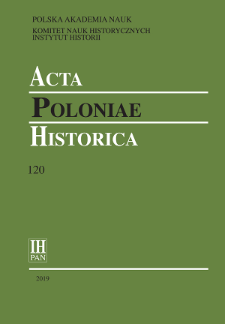- Search in all Repository
- Literature and maps
- Archeology
- Mills database
- Natural sciences
Advanced search
Advanced search
Advanced search
Advanced search
Advanced search

Object
Title: “They Began to Sing Him a Sorhleoð”: Possible Echoes of the Anglo-Saxon Funerary Rites in ‘The Dream of the Rood’
Subtitle:
Acta Poloniae Historica T. 120 (2019), Studies
Contributor:
Instytut Historii Polskiej Akademii Nauk
Publisher:
Place of publishing:
Description:
Type of object:
Abstract:
The Dream of the Rood constitutes one of the most intriguing products of Old English literature, both in terms of its highly imaginative, heroicised depiction of Christ and the Cross and on account of its numerous Christian and pre-Christian intersections. One of the most arresting issues in it, however, particularly as regards the poem’s cultural background, is its mention of a sorhleoð (l. 67), the ‘sorrow-song’, or ‘dirge’ that the disciples begin to sing once they have placed the body of the Saviour in the sepulchre. Given that there is no mention of any songs being chanted at the time of Christ’s burial in the canonical Gospels, it seems rational to suggest that the anonymous poet must have supplied this ‘missing’ information on the basis of his own, perhaps somewhat antiquarian, knowledge of the burial customs in Anglo-Saxon England.
References:
The Catholic Bible: Revised Standard Version (San Francisco, 2006)
Dickins Bruce and Ross Alan S.C. (eds.), The Dream of the Rood (London, 1951)
Kroonen Guus, Etymological Dictionary of Proto-Germanic (Leiden and Boston, 2013)
O’Brien O’Keeffe Katherine, ‘Values and Ethics in Heroic Literature’, in Malcolm Godden and Michael Lapidge (eds.), The Cambridge Companion to Old English Literature, Second Edition (Cambridge, 2014), 101–19
Owen-Crocker Gale R., The Four Funerals in Beowulf and the Structure of the Poem (Manchester, 2009)
Pollington Stephen, Anglo-Saxon Burial Mounds. Princely Burials in the 6th and 7th Cen- turies (Swaffham, 2008)
Swanton Michael (ed.), The Dream of the Rood (Exeter, 2000)
Tacitus Publius Cornelius, Germania (Poznań, 2008)
Valsamis George (ed.), The New Testament: Original Greek (Koine) Text (Athens, 2012)
Webster Leslie, ‘Archaeology and Beowulf’, in Daniel Donoghue (ed.), Beowulf. A Verse Translation (New York and London, 2002), 212–23
Wrenn Charles Leslie and French Bolton Whitney (eds.), Beowulf (Exeter, 1996)
Relation:
Volume:
Start page:
End page:
Detailed Resource Type:
Format:
Resource Identifier:
oai:rcin.org.pl:116510 ; 0001-6829 ; 2450-8462 ; 10.12775/APH.2019.120.01
Source:
IH PAN, sygn. A.295/120 Podr. ; IH PAN, sygn. A.296/120 ; click here to follow the link
Language:
Rights:
Licencja Creative Commons Uznanie autorstwa-Bez utworów zależnych 4.0
Terms of use:
Zasób chroniony prawem autorskim. [CC BY-ND 4.0 Międzynarodowe] Korzystanie dozwolone zgodnie z licencją Creative Commons Uznanie autorstwa-Bez utworów zależnych 4.0, której pełne postanowienia dostępne są pod adresem: ; -
Digitizing institution:
Instytut Historii Polskiej Akademii Nauk
Original in:
Biblioteka Instytutu Historii PAN
Projects co-financed by:
Ministra Nauki i Szkolnictwa Wyższego ; Narodowy Program Rozwoju Humanistyki
Access:
Object collections:
- Digital Repository of Scientific Institutes > Partners' collections > Institute of History PAS > Serials
- Digital Repository of Scientific Institutes > Partners' collections > Institute of History PAS > Institute Publications
- Digital Repository of Scientific Institutes > Partners' collections > Institute of History PAS > Institute Publications > Journals
- Digital Repository of Scientific Institutes > Partners' collections > Institute of History PAS > Institute Publications > Journals > Acta Poloniae Historica
- Digital Repository of Scientific Institutes > Literature > Journals/Articles
Last modified:
Sep 22, 2023
In our library since:
Mar 9, 2020
Number of object content downloads / hits:
145
All available object's versions:
https://rcin.org.pl./publication/144441
Show description in RDF format:
Show description in RDFa format:
Show description in OAI-PMH format:
Objects Similar
Maryjka, Wojciech
Michałowska, Anna
Śniedziewski, Piotr
Magryś, Roman
Mileszczyk, Robert
Kantor, Vladimir

 INSTYTUT ARCHEOLOGII I ETNOLOGII POLSKIEJ AKADEMII NAUK
INSTYTUT ARCHEOLOGII I ETNOLOGII POLSKIEJ AKADEMII NAUK
 INSTYTUT BADAŃ LITERACKICH POLSKIEJ AKADEMII NAUK
INSTYTUT BADAŃ LITERACKICH POLSKIEJ AKADEMII NAUK
 INSTYTUT BADAWCZY LEŚNICTWA
INSTYTUT BADAWCZY LEŚNICTWA
 INSTYTUT BIOLOGII DOŚWIADCZALNEJ IM. MARCELEGO NENCKIEGO POLSKIEJ AKADEMII NAUK
INSTYTUT BIOLOGII DOŚWIADCZALNEJ IM. MARCELEGO NENCKIEGO POLSKIEJ AKADEMII NAUK
 INSTYTUT BIOLOGII SSAKÓW POLSKIEJ AKADEMII NAUK
INSTYTUT BIOLOGII SSAKÓW POLSKIEJ AKADEMII NAUK
 INSTYTUT CHEMII FIZYCZNEJ PAN
INSTYTUT CHEMII FIZYCZNEJ PAN
 INSTYTUT CHEMII ORGANICZNEJ PAN
INSTYTUT CHEMII ORGANICZNEJ PAN
 INSTYTUT FILOZOFII I SOCJOLOGII PAN
INSTYTUT FILOZOFII I SOCJOLOGII PAN
 INSTYTUT GEOGRAFII I PRZESTRZENNEGO ZAGOSPODAROWANIA PAN
INSTYTUT GEOGRAFII I PRZESTRZENNEGO ZAGOSPODAROWANIA PAN
 INSTYTUT HISTORII im. TADEUSZA MANTEUFFLA POLSKIEJ AKADEMII NAUK
INSTYTUT HISTORII im. TADEUSZA MANTEUFFLA POLSKIEJ AKADEMII NAUK
 INSTYTUT JĘZYKA POLSKIEGO POLSKIEJ AKADEMII NAUK
INSTYTUT JĘZYKA POLSKIEGO POLSKIEJ AKADEMII NAUK
 INSTYTUT MATEMATYCZNY PAN
INSTYTUT MATEMATYCZNY PAN
 INSTYTUT MEDYCYNY DOŚWIADCZALNEJ I KLINICZNEJ IM.MIROSŁAWA MOSSAKOWSKIEGO POLSKIEJ AKADEMII NAUK
INSTYTUT MEDYCYNY DOŚWIADCZALNEJ I KLINICZNEJ IM.MIROSŁAWA MOSSAKOWSKIEGO POLSKIEJ AKADEMII NAUK
 INSTYTUT PODSTAWOWYCH PROBLEMÓW TECHNIKI PAN
INSTYTUT PODSTAWOWYCH PROBLEMÓW TECHNIKI PAN
 INSTYTUT SLAWISTYKI PAN
INSTYTUT SLAWISTYKI PAN
 SIEĆ BADAWCZA ŁUKASIEWICZ - INSTYTUT TECHNOLOGII MATERIAŁÓW ELEKTRONICZNYCH
SIEĆ BADAWCZA ŁUKASIEWICZ - INSTYTUT TECHNOLOGII MATERIAŁÓW ELEKTRONICZNYCH
 MUZEUM I INSTYTUT ZOOLOGII POLSKIEJ AKADEMII NAUK
MUZEUM I INSTYTUT ZOOLOGII POLSKIEJ AKADEMII NAUK
 INSTYTUT BADAŃ SYSTEMOWYCH PAN
INSTYTUT BADAŃ SYSTEMOWYCH PAN
 INSTYTUT BOTANIKI IM. WŁADYSŁAWA SZAFERA POLSKIEJ AKADEMII NAUK
INSTYTUT BOTANIKI IM. WŁADYSŁAWA SZAFERA POLSKIEJ AKADEMII NAUK




































